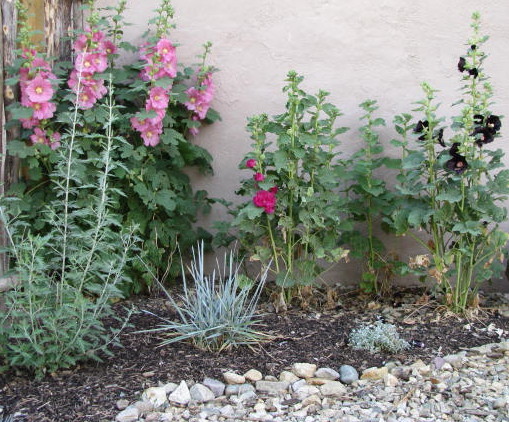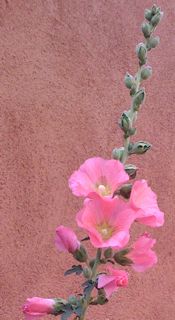Los Jardineros
Garden Club 0f Taos
Hollyhock History
The hollyhock is the official flower of the Taos Garden Club and has long since been unofficially accepted as the floral symbol of the Town of Taos. It is well-chosen, for no other plant has 
Its genaeological background is long and interesting. Its botanical name is Althea rosea, a genus of the Mallow Family, and a cousin to the exotic hibiscus of the tropics, as well as to the practical okra and cottons of the temperate zones. Its common name derives from Hocys Bengaida, a name given in Wales to the Malva benedictus, "holy mallow" of medieval  Latin literature. Wedgewood, an English botanist, says that it was called "holy" because the first of the plants brought to southern Europe came from the Holy Land, to which it had been transplanted from China, its original home. Its characteristic of survival in all climates and soils had caused it to be transplanted to all parts of the civilized world during the Middle Ages, and it is mentioned as "holy-hoke," an adaptation of the Welsh name, in a British horticultural treatise of 1548.
Latin literature. Wedgewood, an English botanist, says that it was called "holy" because the first of the plants brought to southern Europe came from the Holy Land, to which it had been transplanted from China, its original home. Its characteristic of survival in all climates and soils had caused it to be transplanted to all parts of the civilized world during the Middle Ages, and it is mentioned as "holy-hoke," an adaptation of the Welsh name, in a British horticultural treatise of 1548.
To the Spanish, the plant was generally known as Las Varas de San Jose, "rods (or staffs) of St. Joseph," and as such it was pictured in many early paintings of St. Joseph in southern Europe, its quality of enduring all manner of circumstances in all climates and soils typifying God's love and mercy for mankind. In this way, it came to have a very special meaning for our Spanish colonists who brought the seed from the Mother Country in the earliest years of settlement. The Spanish people have ever been lovers of flowers, and even in arid New Mexico, the doñas and their gardeners soon had flowers lining their portales and bordering their adobe walls. The hollyhocks survived when many more tender plants could not abide the rigors of late spring and early autumn frosts, burning noon-day sun, and persistent drought; and so they became the favorites; seed was shared; and soon, as one of my aged neighbors has said, "Everyone had hollyhocks."
We of the Garden Club cherish a story from a biography of Mrs. Teresina Bent Scheurich, the daughter of Charles Bent, our martyred first governor of Territorial New Mexico. She was born in the Old Bent Home, now an interesting Anglo-pioneer museum on the heart of town. Miss Bent married Aloys Scheurich, a German-born musician, who came to town in 1859. While in St. Louis on his way to the West, he became intrigued with the tales of the traders who drove their lumbering ox-wagons back and forth over the Santa Fe Trail. He bought a freight outfit and came to Santa Fe, and - of course - on to Taos.
When he met the gracious Miss Teresina, he decided to make his headquarters here too, and their mutual interest in music, their violin and piano duets, soon developed into a romantic attachment. In 1860 they were married, and in 1865, when his trading had prospered, they bought the home on Teresina Lane, commonly called Bank Alley at present and now occupied by a well-known restaurant and exclusive shops. It is said to be the second oldest house in town and had once been the thick-walled fortress-residence protecting the southwest corner of the town's first walled plaza compound.
When the place had been put in order and additions made, there were 29 rooms that housed the family and their servants. There was a zaguan which has been left intact and now leads to a parking lot, but very little of the once-spacious patio remains unroofed.
In the original patio Teresina had a lovely garden; and according to her granddaughter, Tessie Berry, the first thing she did after planting trees and vines was to send to St. Louis to a seedsman acquaintance of her husband for the first commercially packaged flower seeds that came to Taos, and they came of course in a freight wagon over the Santa Fe Trail.
She loved the Valley's Varas de San Jose and sent for gorgeous double varieties of hollyhocks in every shade, along with Butones de Oros, as the Spanish called marigolds. (Isn't that a lovely name for marigolds - Butones de Oro - Buttons of Gold?) True to tradition, the hollyhocks flourished; Mrs. Scheurich shared them with her neighbors and friends; and new strains were added to our favorite flower. When I came to Taos almost 30 years ago, I found several homes with plantings which their proud owners claimed to be descendants of that precious stock.
The Taos Garden Club was organized in 1949 by Mrs. Donald G. Secrest who became its first president. She too loved the hollyhocks, and at her suggestion the club's first project was the scattering of seeds along the main highways leading to town, along residence streets and downtown alleys and in the Plaza. Encouragement was given to the owners of service stations, hotels, motels, and the owners of conspicuous vacant lots to plant hollyhocks, with the Club furnishing seed when necessary. By the second and third year after the seeds were in, the results were quite spectacular. Tourists began to pick seeds from these plantings, and club members packaged seeds to give to visitors and to be distributed at the Chamber of Commerce.
Unfortunately, the various highway and street paving projects and the installation of water mains in the interim destroyed most of these efforts, but still hollyhocks remain in abundance as anyone can see who comes into town from any direction. The club is perennially grateful to the many townspeople who continue to use them as their chief summer floral display in public and private gardens. Just look about you as you drive around within the next few days, and you will know why the hollyhock is our Taos flower.